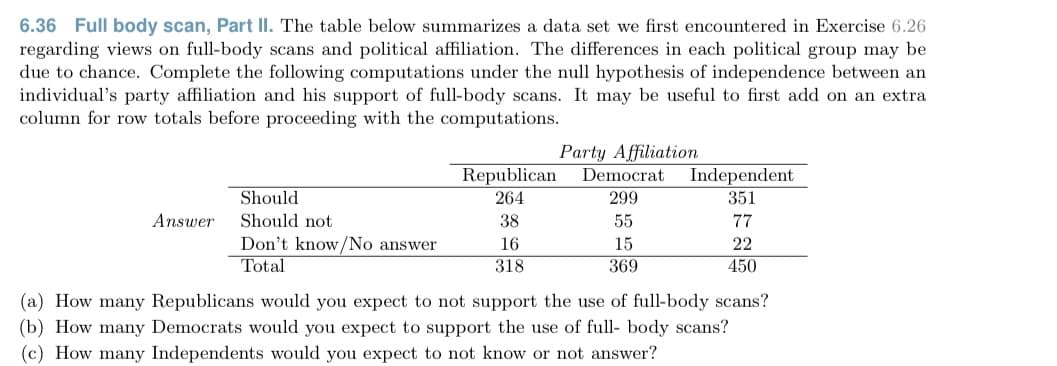6.36 Full body scan, Part II. The table below summarizes a data set we first encountered in Exercise 6.26 regarding views on full-body scans and political affiliation. The differences in each political group may be due to chance. Complete the following computations under the null hypothesis of independence between an individual's party affiliation and his support of full-body scans. It may be useful to first add on an extra column for row totals before proceeding with the computations. Party Affiliation Republican 264 Independent Democrat Should 299 351 Answer Should not 38 55 77 Don't know/No answer Total 16 15 22 318 369 450 (a) How many Republicans would you expect to not support the use of full-body scans? (b) How many Democrats would you expect to support the use of full- body scans? (c) How many Independents would you expect to not know or not answer?
6.36 Full body scan, Part II. The table below summarizes a data set we first encountered in Exercise 6.26 regarding views on full-body scans and political affiliation. The differences in each political group may be due to chance. Complete the following computations under the null hypothesis of independence between an individual's party affiliation and his support of full-body scans. It may be useful to first add on an extra column for row totals before proceeding with the computations. Party Affiliation Republican 264 Independent Democrat Should 299 351 Answer Should not 38 55 77 Don't know/No answer Total 16 15 22 318 369 450 (a) How many Republicans would you expect to not support the use of full-body scans? (b) How many Democrats would you expect to support the use of full- body scans? (c) How many Independents would you expect to not know or not answer?
Algebra & Trigonometry with Analytic Geometry
13th Edition
ISBN:9781133382119
Author:Swokowski
Publisher:Swokowski
Chapter10: Sequences, Series, And Probability
Section10.8: Probability
Problem 29E
Related questions
Question
100%

Transcribed Image Text:6.36 Full body scan, Part II. The table below summarizes a data set we first encountered in Exercise 6.26
regarding views on full-body scans and political affiliation. The differences in each political group may be
due to chance. Complete the following computations under the null hypothesis of independence between an
individual's party affiliation and his support of full-body scans. It may be useful to first add on an extra
column for row totals before proceeding with the computations.
Party Affiliation
Republican
264
Independent
351
Democrat
Should
299
Answer
Should not
38
55
77
Don't know/No answer
Total
16
15
22
318
369
450
(a) How many Republicans would you expect to not support the use of full-body scans?
(b) How many Democrats would you expect to support the use of full- body scans?
(c) How many Independents would you expect to not know or not answer?
Expert Solution
This question has been solved!
Explore an expertly crafted, step-by-step solution for a thorough understanding of key concepts.
This is a popular solution!
Trending now
This is a popular solution!
Step by step
Solved in 2 steps with 1 images

Recommended textbooks for you

Algebra & Trigonometry with Analytic Geometry
Algebra
ISBN:
9781133382119
Author:
Swokowski
Publisher:
Cengage

Algebra & Trigonometry with Analytic Geometry
Algebra
ISBN:
9781133382119
Author:
Swokowski
Publisher:
Cengage